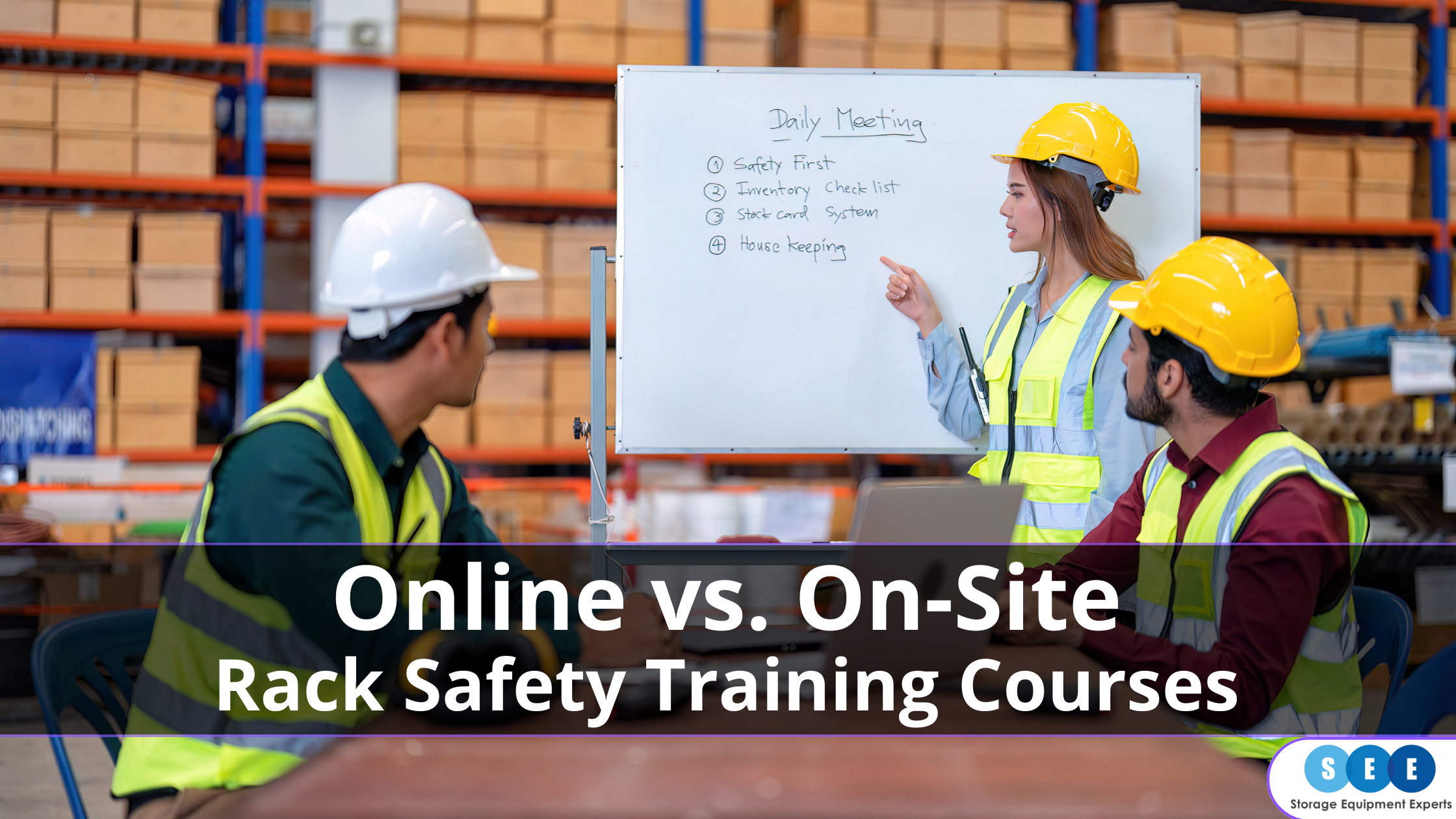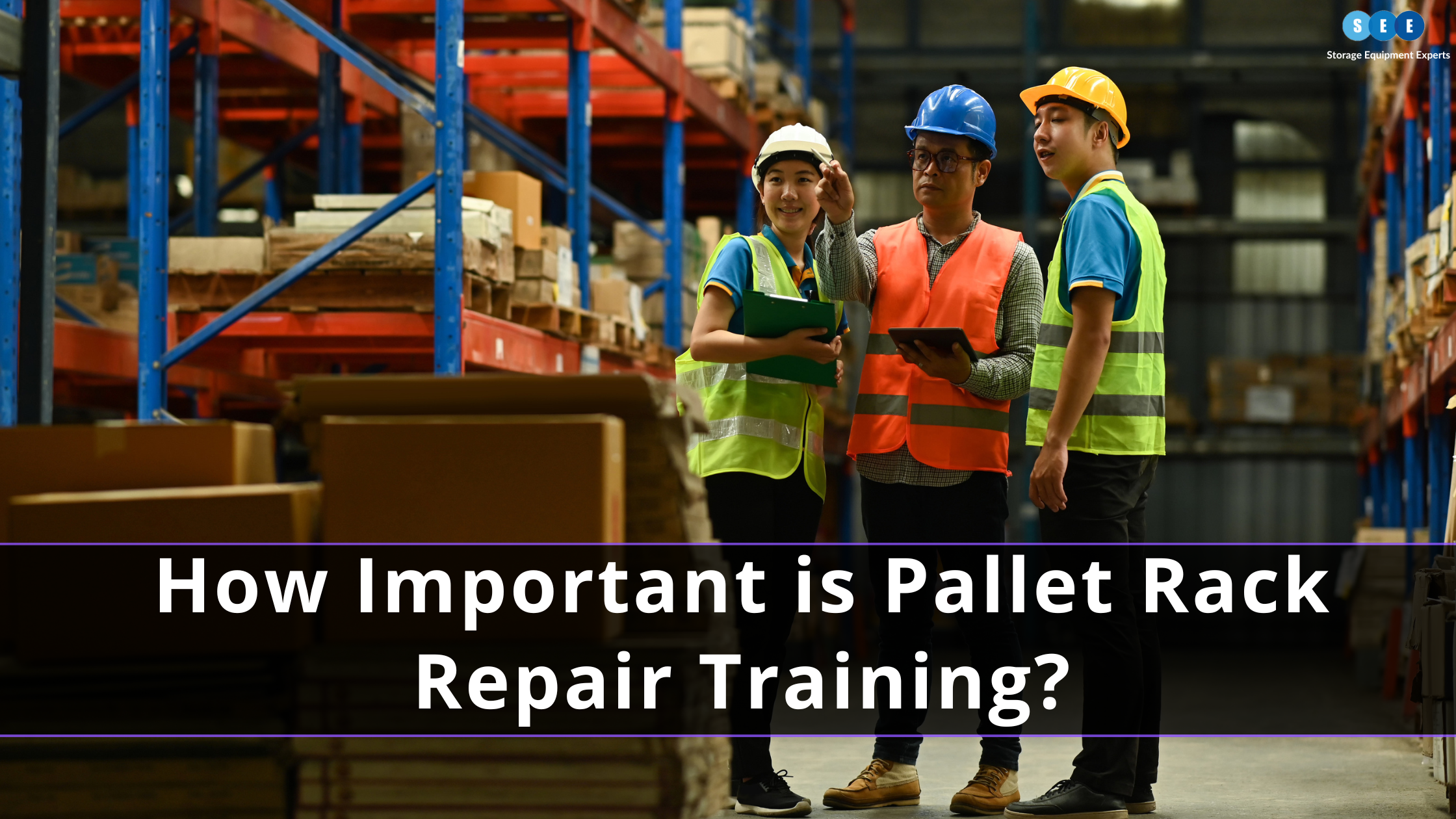Benefits of Online vs. On-Site Rack Safety Training Courses
Rack safety training is a core piece of the warehouse safety (and productivity) puzzle. Training new employees on rack safety or providing refresher courses to experienced workers is a natural part of the ongoing training you should provide to your staff – both for their overall health and safety and to minimise potentially expensive disruptions to operations.
There are two primary training options available: online training and on-site training. Each has its distinct advantages, and understanding the benefits of both will help you determine which is best suited to your team and operational needs.
In this blog, we’ll explore the benefits of online versus on-site warehouse racking safety training courses and help you make an informed decision.
1. Flexibility and Convenience
One major factor differentiating online training from on-site training is flexibility. Online courses are well-known for their ability to accommodate various schedules and learning speeds.
Online Safety Training
- Employees can complete courses at their own speed, allowing them to absorb the material more thoroughly without the pressure of a fixed schedule.
- Online training is accessible anytime, anywhere. This means that employees can fit learning into their day without disrupting regular operations.
- Since online courses can be taken during off-hours or breaks, they don’t interfere with the daily workflow or cause operational downtime.
On-Site Safety Training
- On-site training, conducted during working hours, often provides immediate feedback and opportunities for live interaction.
- On-site sessions can bring the entire team together, promoting a shared learning experience. This ensures that everyone receives the same level of training at the same time.
While online training offers more flexibility, on-site training ensures everyone is on the same page, making it easier for managers to assess progress.
2. Hands-on Experience and Practical Application
The most significant advantage of on-site training is the opportunity for hands-on experience and practical application. While online courses can provide detailed information, there’s something irreplaceable about learning on the job.
Online Safety Training
- Online courses often provide an in-depth understanding of safety procedures, regulations, and compliance standards. However, they typically lack the real-time application that on-site training offers.
- Some online courses use simulation tools or video tutorials to demonstrate real-life scenarios, but these can’t always replicate the nuances of an actual working environment.
On-Site Safety Training
- On-site training takes place in the warehouse, meaning that employees can directly apply what they are learning to the actual racking systems they will be working with.
- During on-site training, participants can practice their skills immediately. They can physically inspect racking systems, understand how weight is distributed, and practice proper loading techniques under the guidance of a trainer.
- Being in the same environment as the racking systems allows employees to ask specific, practical questions and receive instant feedback.
While online training is excellent for foundational knowledge, on-site training excels in hands-on learning and real-world application.
3. Cost Considerations
Cost is, of course, a significant factor – especially when training large teams or distributed workforces.
Online Safety Training
- Online training often proves more cost-effective, especially for large teams. There’s no need to pay for trainers, travel, or accommodation. All materials are digital, eliminating the need for physical resources.
- Employees can complete the course from anywhere, meaning there are no added travel or accommodation costs for off-site employees.
On-Site Safety Training
- On-site training often comes with higher upfront costs. This includes hiring professional trainers, providing materials, and possibly paying for travel and accommodation for employees.
- Although on-site training may be more expensive initially, it often delivers higher value in terms of practical application and real-time problem-solving, which can enhance efficiency and reduce long-term risks.
Online training may be more affordable upfront, but for warehouses that require hands-on, immediate learning, the investment in on-site training can yield considerable long-term benefits.
4. Tailored Content and Personalisation
Both online and on-site training can be customised to some extent, but each offers different levels of personalisation.
Online Safety Training
- Many online courses are pre-designed, which allows employees to quickly access materials. However, these modules are often more general and may not account for the specific needs of your warehouse operations.
- Some online training platforms allow for customisation, letting you add your own materials, examples, or assessments based on your warehouse’s unique racking systems and safety requirements.
On-Site Safety Training
- On-site training can be tailored to the specific needs of your warehouse, offering a highly personalised learning experience. The trainer can walk through your warehouse and address particular challenges related to your racking systems.
- Because the training takes place in your actual working environment, trainers can create scenarios based on real situations that have occurred or are likely to happen. This means employees learn how to tackle real-world issues.
When it comes to tailoring content to the exact needs of your team and facility, on-site training offers a higher degree of customisation. However, online training platforms are catching up, with many offering customisable features.
5. Monitoring Progress and Assessments
Tracking the progress of employees during and after the training is an essential part of ensuring that the lessons have been absorbed and that the training is effective.
Online Safety Training
- Online courses often come with learning management systems (LMS) that allow you to track employee progress automatically. Managers can view reports, quiz scores, and completion rates in real time.
- Online training frequently includes built-in quizzes, tests, and assessments to measure understanding and retention.
- Many online courses offer certificates upon completion, which can serve as a record of compliance training.
On-Site Safety Training
- In on-site training, progress often has to be manually tracked through written assessments or practical evaluations. Trainers typically provide feedback directly to the managers after the training is completed.
- Practical, hands-on assessments during on-site training allow trainers to evaluate how well employees apply what they’ve learned in real-world conditions.
- On-site training allows trainers to assess team dynamics and ensure everyone is working together safely and effectively.
Online training excels in terms of progress monitoring and automation, but on-site training provides more thorough, real-time assessments of practical skills.
6. Long-Term Learning and Retention
Retaining information after training is a key concern for any warehouse manager. The training format plays a large role in how well employees retain and apply what they’ve learned.
Online Rack Safety Training
- Employees can revisit the content as often as needed, allowing for repetition and reinforcement of key concepts. This can lead to better retention of theoretical knowledge.
- Many online platforms provide access to resources, such as downloadable guides or videos, which employees can refer back to when needed.
On-Site Rack Safety Training
- On-site training ensures that employees immediately apply what they’ve learned. The physical act of practising safety techniques can help reinforce lessons and improve retention.
- Some on-site trainers provide follow-up sessions or refresher courses to ensure employees retain what they’ve learned over the long term.
Both online and on-site training can provide strong retention, but on-site training tends to leave a lasting impact due to its interactive and hands-on approach.
Conclusion
Choosing between online and on-site rack safety training depends on your team’s specific needs, your budget, and the nature of your warehouse operations. Online training offers flexibility, affordability, and easy progress tracking, making it ideal for large teams or remote workers. On the other hand, on-site training provides invaluable hands-on experience, real-world application, and personalised content, which can lead to a more effective and practical learning experience.
Ultimately, the right decision may involve blending both formats to achieve the best results for your team’s safety and the efficiency of your warehouse. You can get more guidance and information by reaching out to SEE Racking Inspections.











